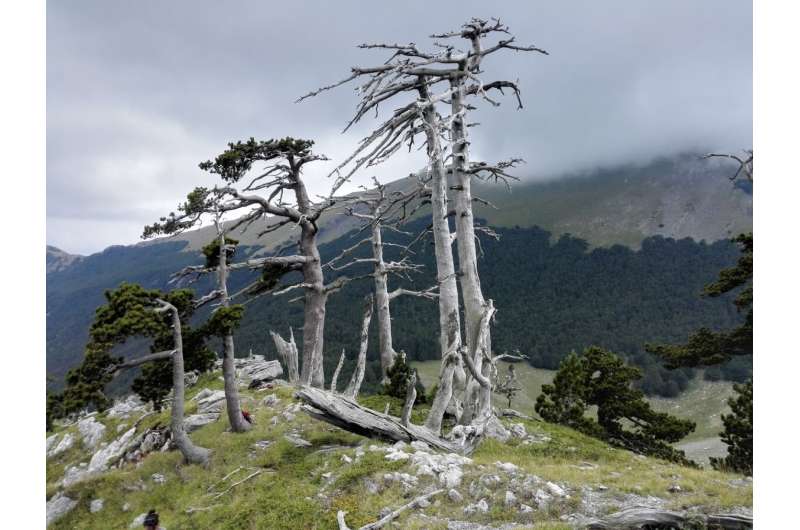Old pine trees witness the rewilding in Mediterranean mountain forests in consequence of late-medieval pandemics

Subalpine ecosystems are natural laboratories to study the evolution of global warming, since their dynamics are particularly sensitive to temperature changes. However, the impacts of past pandemics and land-use changes on mountain forest dynamics are still overlooked. An international study based on the establishment date of pine trees shows that a large-scale rewilding occurred after the late-medieval Black Death pandemic and successive pandemics, which led to a profound landscape transformation in southern European mountains. This evidence helps to understand the long-term human legacies on mountain forests.
A recent study published in Global Change Biology, led by the University of Valladolid (Spain) and the University of Tuscia (Italy), in collaboration with researchers from the University of Mainz (Germany), the University of Cambridge (UK), and the Pyrenean Institute of Ecology (CSIC, Spain), finds that the Black Death's impacts were deeper and longer-lasting than expected. The researchers analyzed 1,146 ancient trees in three high-elevation pine forests (Pinus heldreichii and Pinus uncinata) in southern Europe. The uniqueness of these well-preserved forests is reflected in the presence of some of the oldest trees in Europe, exceeding 1000 years of life (e.g., Italus and Adonis). These forests are located in the Pyrenees (northeastern Spain), Pollino (southern Italy) and Mt. Smolikas (northern Greece).
The authors found synchronous peaks of tree establishment in the late 15th and early 16th centuries, the period following the great pandemics and accompanying societal instability. The robustness of these results in the three analyzed forests suggested a large-scale landscape transformation in the mountain ecosystems. First author Gabriel Sangüesa-Barreda from the University of Valladolid says, "This is a unique effort made by colleagues from different institutions in Spain, Italy, Germany and UK to identify a historic rewildening across much of the Mediterranean region."
The late-medieval crisis caused the cessation of grazing activities
Intense human activities during the Medieval period deeply affected the mountain systems of Europe. At that time, mountain pastures represented a fundamental resource for the local population. The late-Medieval crisis of the 14th and 15th centuries, documented by recurrent famines, the Black Death pandemic and political turmoil, led to a large-scale depopulation of rural areas. Therefore, the agro-pastoral activities in the following decades and centuries terminated or decreased considerably. The tree-ring information analyzed in this study indicates that the abandoned pastures were progressively dominated by pines after a period when stands with mature reproductive trees were restored, and soils capable of harboring pine saplings formed.
In addition to the societal dynamics, the cooler and more unstable climate conditions during the Little Ice Age also played a role in the cessation of grazing activities in the high-elevation belt.
A heritage from the late-Medieval crisis
"This study points that the current abundance of old trees and mature forests in southern European mountains may be a consequence of this historical process, and the current high-mountain landscape with patches of old growth stands is a heritage from the late Medieval rewilding," says Gianluca Piovesan from University of Tuscia. These long-living forest ecosystems can stock carbon for centuries, protecting biodiversity. Therefore, its strict conservation is essential to avoid losing these last stands of ancient trees.
A historical analog to recent rewilding
In the Mediterranean mountains, a new wave of forest colonization is taking place in the subalpine environments. In this case, the cessation of traditional land use started in the second half of the 20th century, and it is showing a gradual conversion of subalpine grasslands to forests. The cause of the land use abandonment is the exodus of the rural population toward cities, but the effect on the rewilding mountain landscape is similar to that of the early phase of the late-Medieval crisis. However, warmer temperatures due to climate change and increasing air concentrations of N and CO2 may also favor the rapid expansion.
More information: Gabriel Sangüesa‐Barreda et al. Climate‐human interactions contributed to historical forest recruitment dynamics in Mediterranean subalpine ecosystems, Global Change Biology (2020). DOI: 10.1111/gcb.15246
Journal information: Global Change Biology
Provided by University of Tuscia



















